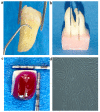Cytotoxic Effects on Gingival Mesenchymal Stromal Cells and Root Surface Modifications Induced by Some Local Antimicrobial Products Used in Periodontitis Treatment
- PMID: 34501140
- PMCID: PMC8434495
- DOI: 10.3390/ma14175049
Cytotoxic Effects on Gingival Mesenchymal Stromal Cells and Root Surface Modifications Induced by Some Local Antimicrobial Products Used in Periodontitis Treatment
Abstract
(1) Background: this study aims to test the cytotoxicity of three antimicrobial products used in periodontitis treatment on gingival mesenchymal stem cells (gMSCs) and their influence on root surfaces and gMSC adhesion. We tested the null hypothesis that the effects of the antimicrobials did not differ. (2) Methods: the commercial products based on sulphonic/sulphuric acids, sodium hypochlorite and silver nanoparticles, in five different concentrations, were added to culture medium for growing gMSCs. Cell proliferation capacity was tested using the Cell Counting Kit-8 (CCK8) and their viability was determined by succinate dehydrogenase activity (MTT) assay. Scanning electron microscopy evaluated the adhesion of gMSCs on root samples treated mechanically and with commercial products. (3) Results: the products induced a dose-dependent cytotoxicity in terms of reduced proliferation and viability of gMSCs, as well as cell shape modifications. Significant differences in CCK8 values between the different commercial products were observed. Based on proliferation tests, the null hypothesis was rejected. When MTT values of the three products were compared with each other, no significant differences were observed for any of the five concentrations (p = 0.065, p = 0.067, p = 0.172, p = 0.256, p = 0.060). (4) Conclusions: the three antimicrobials had a certain degree of cytotoxicity on gMSCs. gMSCs repopulated treated root surfaces.
Keywords: adhesion; dental disinfectant; smear layer; stem cell; tooth root.
Conflict of interest statement
The authors declare no conflict of interest.
Figures




Similar articles
-
Modulation of proliferation and differentiation of gingiva‑derived mesenchymal stem cells by concentrated growth factors: Potential implications in tissue engineering for dental regeneration and repair.Int J Mol Med. 2019 Jul;44(1):37-46. doi: 10.3892/ijmm.2019.4172. Epub 2019 Apr 24. Int J Mol Med. 2019. PMID: 31017269 Free PMC article.
-
The Cytotoxicity of Dental Restorative Materials on Gingival Stromal Mesenchymal Cells-an In Vitro Study.Curr Health Sci J. 2022 Jul-Sep;48(3):331-339. doi: 10.12865/CHSJ.48.03.12. Epub 2022 Sep 30. Curr Health Sci J. 2022. PMID: 36815086 Free PMC article.
-
Chronic inflammation on gingiva-derived mesenchymal stem cells.Bioinformation. 2023 Jan 31;19(1):138-142. doi: 10.6026/97320630019138. eCollection 2023. Bioinformation. 2023. PMID: 37720288 Free PMC article.
-
Stemness Potency of Human Gingival Cells-Application in Anticancer Therapies and Clinical Trials.Cells. 2020 Aug 18;9(8):1916. doi: 10.3390/cells9081916. Cells. 2020. PMID: 32824702 Free PMC article. Review.
-
Updates on GMSCs Treatment for Autoimmune Diseases.Curr Stem Cell Res Ther. 2018;13(5):345-349. doi: 10.2174/1574888X13666180220141114. Curr Stem Cell Res Ther. 2018. PMID: 29468980 Review.
Cited by
-
Nursing for conical telescopic crown prosthodontics in treating periodontitis accompanied by dentition defects.Afr Health Sci. 2024 Dec;24(4):383-388. doi: 10.4314/ahs.v24i4.47. Afr Health Sci. 2024. PMID: 40190513 Free PMC article. Clinical Trial.
-
Agave amica (Medik.) Thiede & Govaerts (Asparagaceae)-Insights into Its Valuable Phenolic Profile and In Vitro Antimicrobial, Antibiofilm, Antioxidative, and Antiproliferative Properties.Antibiotics (Basel). 2025 Jun 23;14(7):638. doi: 10.3390/antibiotics14070638. Antibiotics (Basel). 2025. PMID: 40723941 Free PMC article.
-
The Treatment of Severe Periodontitis Using a Local Antiseptic Desiccant and Subgingival Mechanical Instrumentation: A Pilot Study.J Clin Med. 2023 Jun 26;12(13):4286. doi: 10.3390/jcm12134286. J Clin Med. 2023. PMID: 37445321 Free PMC article.
-
Revealing the Phenolic Composition and the Antioxidant, Antimicrobial and Antiproliferative Activities of Two Euphrasia sp. Extracts.Plants (Basel). 2024 Jun 28;13(13):1790. doi: 10.3390/plants13131790. Plants (Basel). 2024. PMID: 38999630 Free PMC article.
-
A Local Desiccant Antimicrobial Agent as an Alternative to Adjunctive Antibiotics in the Treatment of Periodontitis: A Narrative Review.Antibiotics (Basel). 2023 Feb 24;12(3):456. doi: 10.3390/antibiotics12030456. Antibiotics (Basel). 2023. PMID: 36978324 Free PMC article. Review.
References
Grants and funding
LinkOut - more resources
Full Text Sources

